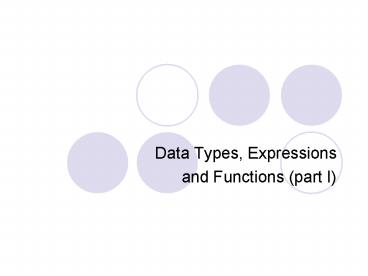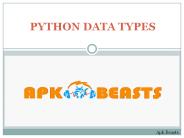Data Types, Expressions - PowerPoint PPT Presentation
1 / 41
Title:
Data Types, Expressions
Description:
constants of type int and float. evaluating arithmetic expressions ... dogs--; --dogs; USE EITHER. BUT... is evaluated to a value of a given type ... – PowerPoint PPT presentation
Number of Views:190
Avg rating:3.0/5.0
Title: Data Types, Expressions
1
- Data Types, Expressions
- and Functions (part I)
2
Topics
- constants of type int and float
- evaluating arithmetic expressions
- implicit type coercion and explicit type
conversion - calling a value-returning function
- using function arguments
- using C library functions in expressions
3
Standard Data Types in C
- Integral Types
- represent whole numbers and their negatives
- declared as int, short, or long
- Floating Types
- represent real numbers with a decimal point
- declared as float or double
- Character Type
- represents single characters
- declared as char
4
Samples of C Data Values
- int sample values
- 4578 -4578 0
- float sample values
- 95.274 95. .265
- 9521E-3 -95E-1 95.213E2
- char sample values
- B d 4 ?
5
Scientific Notation
2.7E4 means 2.7 x 10 4 2.7000
27000.0 2.7E-4 means
2.7 x 10 - 4 0002.7
0.00027
6
More About Floating Point Values
- Floating point numbers have an integer part and a
fractional part, with a decimal point in between.
Either the integer part or the fractional part,
but not both, may be missing - Examples 18.4 500. .8
-127.358 - Alternatively, floating point values can have an
exponent, as in scientific notation--the number
preceding the letter E doesnt need to include a
decimal point (E can be upper or lower case) - Examples 1.84E1 5E2 8E-1
-.127358E3
7
Division Operator
- The result of the division operator depends on
the type of its operands - If one or both operands has a floating point
type, the result is a floating point type.
Otherwise, the result is an integer type (it
truncates!!) - Examples 11 / 4 has value
2 11.0 / 4.0 has value 2.75 11 /
4.0 has value 2.75 - 11.0 / 4 has value 2.75
8
Find the Middle
//
// FreezeBoil program // This program
computes the midpoint between // the freezing and
boiling points of water //
include lt iostream
gt using namespace std const float FREEZE_PT
32.0 // Freezing point of water const float
BOIL_PT 212.0 // Boiling point of water int
main() float avgTemp // Holds the
result of averaging // FREEZE_PT and
BOIL_PT
9
Find the Middle (continued)
cout ltlt Water freezes at ltlt FREEZE_PT
ltlt endl cout ltlt and boils at ltlt
BOIL_PT ltlt degrees. ltlt endl
avgTemp FREEZE_PT BOIL_PT avgTemp
avgTemp / 2.0 cout ltlt Halfway between
is cout ltlt avgTemp ltlt degrees. ltlt
endl return 0
10
Modulus Operator
- The modulus operator can only be used with
integer type operands and always has an integer
type result - Its result is the integer remainder of an integer
division - Example 11 4 has value 3 because
R ?
)
4
11
11
More C Operators
RAM
int age age 8 age age 1
age
8
9
12
Prefix FormIncrement Operator
int age age 8 age
8
age
9
age
13
Postfix Form Increment Operator
int age age 8 age
8
age
9
age
14
Decrement Operator
int dogs dogs 100 dogs--
100
dogs
99
dogs
15
Which Form to Use
- When the increment(or decrement) operator is used
in a stand alone statement solely to add one(or
subtract one) from a variables value, it can be
used in either prefix or postfix form
USE EITHER
dogs-- --dogs
16
BUT...
- You can use increment or decrement operators
INSIDE other statements - example y x
- example if ( x gt 0) cout ltlt x
- You can write very confusing statements!
- example x x x // compiles!
- This is NOT a good idea!!!!
- Use and -- in standalone statements only!
just x or --y
17
What is an Expression in C?
- An expression is a valid arrangement of
variables, constants, and operators - In C each expression is evaluated to a value of
a given type - The value of the expression 9.3 4.5
- is 41.85
- The type of the expression 9.3 4.5 is float
18
Operators can be
- binary involving 2 operands 2 3
- unary involving 1 operand - 3
- ternary involving 3 operands don't!
19
Some of the C Operators
- Precedence Operator Description
- Higher ( ) Function call
- Positive (unary)
- - Negative (unary)
- Multiplication
- / Division
- Modulus(remainder)
- Addition (binary)
- - Subtraction (binary
- Lower Assignment
20
Precedence
- Precedence determines which operator is applied
first in an expression having several operators - higher precedence operators are done first
21
Associativity
- Left to right associativity means that in an
expression having 2 operators with the same
priority, the left operator is applied first - In C the binary operators
- , /, , , - are all left
associative - Expression 9 - 5 - 1 means (9 - 5) - 1
- 4 - 1
- 3
22
Evaluate the Expression
- 7 10 - 5 3 4 9
- (7 10) - 5 3 4 9
- 70 - 5 3 4 9
- 70 -(5 3) 4 9
- 70 - 2 4 9
- 70 - ( 2 4) 9
- 70 - 8 9
- (70 - 8 ) 9
- 62 9
- 71
23
Parentheses
- Parentheses can be used to change the usual order
- Parts in() are evaluated first
- Evaluate (7 (10 - 5) 3) 4 9
- (7 5 3 ) 4 9
- ( 35 3) 4 9
- 2 4 9
- 8 9
- 17
24
Assignment Operator semantics
- Variable Expression
- First the expression on right is evaluated
- Then the resulting value is stored in the memory
location of variable on left - NOTE An automatic implicit type coercion occurs
after evaluation but before the value is stored
if the types differ for expression and variable
25
What value is stored?
- float a
- float b
- a 8.5
- b 9.37
- a b
8.5
?
a
a
9.37
?
b
b
26
What is stored?
float someFloat someFloat someFloat
12 // Causes implicit type conversion
coercion
?
12.0
someFloat
27
What is stored?
int someInt someInt someInt
4.8 // Causes type coercion and data loss!
?
4
someInt
28
Type Casting is Explicit Conversion of one Type
to another
- int(4.8) has value 4
- float(5) has value 5.0
- float(7/4) has value 1.0
- float(7) / float(4) has value 1.75
29
Some Expressions
- int age
- Example Value
- age 8 8
- - age - 8
- 5 8 13
- 5 / 8 0
- 6.0 / 5.0 1.2
- float(4 / 8) 0.0
- float(4) / 8 0.5
30
What values are stored?
- float loCost
- float hiCost
- loCost 12.342
- hiCost 12.348
- loCost
- float(int(loCost 100.0 0.5)) / 100.0
- hiCost
- float(int(hiCost 100.0 0.5)) / 100.0
31
Values were rounded to 2 decimal places
loCost
12.34
12.35
hiCost
32
Functions
- Recall every C program must have a function
called main - Program execution always begins with function
main - Any other functions must be called by your code
to be executed
33
Two types of functions
- Value-returning functions
- called to produce ONE value which is returned to
the caller - example x sqrt(y)
- Void functions
- called to accomplish a job, no value returned
to user - example rectangle (x1, y1, x2, y1)
34
Function Calls
- One function calls another by using the name of
the called function together with() containing an
argument list - x sqrt (25.0) circle (x, y, radius)
- A function call temporarily transfers control
from the calling function to the called function
(that's why it's a control structure)
35
Value-Returning FunctionsHEADER FILE
FUNCTION EXAMPLE VALUE
OF CALL
ltcstdlibgt abs(i) abs(-6) 6
ltcmathgt pow(x,y) pow(2.0,3.0)
8.0
fabs(x) fabs(-6.4) 6.4
ltcmathgt sqrt(x) sqrt(100.0) 10.0
sqrt(x) sqrt(2.0)
1.41421
ltcmathgt log(x) log(2.0)
.693147
36
Some Mathematical Library Functions (continued)
37
Write C Expressions for
- The square root of b2 - 4ac
- sqrt(b b - 4.0 a c)
- The square root of the average of myAge and
yourAge - sqrt((myAge yourAge) / 2)
38
Example sqrt Function
Function sqrt as a black box
Square root function
X is 16.0
Result is 4.0
39
Function Call Semantics
- First the arguments are copied into memory set
aside for the corresponding parameters. - Then control transfers to the called functions
code - When the functions code has finished executing,
the parameters are deallocated (their memory is
freed up) and - control is transferred back to the calling
statement (if is value-returning, brings back
the return value to the calling statement)
40
Value-returning Function Call Syntax
- FunctionName ( Argument List )
- The argument list is a way for functions to
communicate with each other by passing
information - FROM caller TO called function - The argument list can contain zero, one, or more
arguments, separated by commas, depending on the
function
41
Value-returning Function Call Syntax (cont'd)
- The function call is always part of another
statement - an assignment statement
- x sqrt(y)
- an output statement
- cout ltlt sqrt(x)
- (later) an if or a while condition
- if (sqrt (x) gt 50) ...































